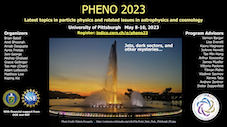Speaker
Description
Measuring the density profile of dark matter in the Solar neighbourhood has important implications for both dark matter theory and experiment. In this work, we apply autoregressive flows to stars from a realistic simulation of a Milky Way-type galaxy to learn – in an unsupervised way – the stellar phase space density and its derivatives. With these as inputs, and under the assumption of dynamic equilibrium, the gravitational acceleration field and mass density can be calculated directly from the Boltzmann equation without the need to assume either cylindrical symmetry or specific functional forms for the galaxy’s mass density. We demonstrate our approach can accurately reconstruct the mass density and acceleration profiles of the simulated galaxy, even in the presence of Gaia-like errors in the kinematic measurements.
